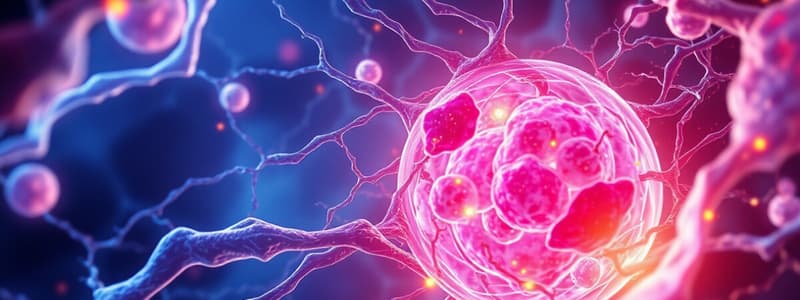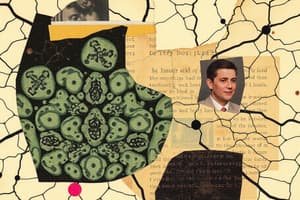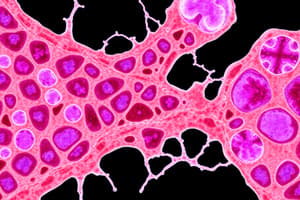Podcast
Questions and Answers
What is the primary role of fibroblasts in connective tissue?
What is the primary role of fibroblasts in connective tissue?
- Production of leukocytes
- Formation of connective tissue fibers and ground substance (correct)
- Formation of adipose tissue
- Regeneration of neural tissue
How do undifferentiated mesenchymal cells (UMCs) contribute to tissue repair?
How do undifferentiated mesenchymal cells (UMCs) contribute to tissue repair?
- They become plasma cells.
- They prevent inflammation.
- They differentiate into various connective tissue cells. (correct)
- They exclusively form adipocytes.
What is the defining feature of myofibroblasts in the context of wound healing?
What is the defining feature of myofibroblasts in the context of wound healing?
- They inhibit scar formation.
- They assist in wound closure through contraction. (correct)
- They are inactive during the healing process.
- They primarily form adipose tissue.
Where are unilocular adipocytes primarily found?
Where are unilocular adipocytes primarily found?
What is a characteristic feature of fixed macrophages in connective tissue?
What is a characteristic feature of fixed macrophages in connective tissue?
What triggers the transition of fibrocytes back to an active fibroblast state during tissue repair?
What triggers the transition of fibrocytes back to an active fibroblast state during tissue repair?
Which type of cell is primarily responsible for scar formation in healing tissues?
Which type of cell is primarily responsible for scar formation in healing tissues?
What appearance do unilocular adipocytes exhibit when stained with H&E?
What appearance do unilocular adipocytes exhibit when stained with H&E?
What is a primary function of multilocular adipocytes (brown fat)?
What is a primary function of multilocular adipocytes (brown fat)?
Which statement accurately describes the origin and function of macrophages?
Which statement accurately describes the origin and function of macrophages?
What characterizes the appearance of reticular cells under light microscopy?
What characterizes the appearance of reticular cells under light microscopy?
Which of the following best describes the role of macrophages within the mononuclear phagocytic system?
Which of the following best describes the role of macrophages within the mononuclear phagocytic system?
What is a distinguishing feature of brown adipocytes compared to white adipocytes?
What is a distinguishing feature of brown adipocytes compared to white adipocytes?
Which cells are part of the mononuclear phagocytic system and are found in the liver?
Which cells are part of the mononuclear phagocytic system and are found in the liver?
In the context of connective tissue, what is the main role of fibroblasts?
In the context of connective tissue, what is the main role of fibroblasts?
What occurs to macrophages when adequately stimulated in a pathological condition?
What occurs to macrophages when adequately stimulated in a pathological condition?
Which characteristic most accurately describes the regenerative capacity of connective tissue?
Which characteristic most accurately describes the regenerative capacity of connective tissue?
What is the primary function of fibroblasts in connective tissue?
What is the primary function of fibroblasts in connective tissue?
How do macrophages function within connective tissue?
How do macrophages function within connective tissue?
Which type of adipocyte is primarily involved in lipid storage and metabolism?
Which type of adipocyte is primarily involved in lipid storage and metabolism?
What role do myofibroblasts play in the healing of connective tissue?
What role do myofibroblasts play in the healing of connective tissue?
Which of the following best describes how extracellular matrix composition varies in different connective tissues?
Which of the following best describes how extracellular matrix composition varies in different connective tissues?
Which component is NOT typically found in the extracellular matrix of connective tissue?
Which component is NOT typically found in the extracellular matrix of connective tissue?
What is the most critical function of the ground substance in connective tissue?
What is the most critical function of the ground substance in connective tissue?
Flashcards are hidden until you start studying
Study Notes
Connective Tissue
- General characters: Mesenchymal origin, consists of cells, fibers (collagen, elastic and reticular), and ground substance.
- Composition: Cells, Ground substance, Connective tissue fibers.
- Extracellular Matrix: Composed of ground substance and connective tissue fibers.
- Functions:
- Support and connection of cells, tissues, and organs.
- Healing of injured tissues.
- Resist stress in cartilage, bone, tendons, ligaments, and organ capsules.
- Medium for exchange in blood, lymph, and connective tissue proper.
- Immunity through plasma, mast cells, and white blood cells entering the connective tissue.
- Lipid storage and metabolism in adipose cells and adipose tissue.
Connective Tissue Cells
- Fixed Cells: Stable and long-lived cells.
- Wandering Free Cells: Transient and migrating cells from blood into the connective tissue.
Undifferentiated Mesenchymal Cells (UMCs)
- Stem cell.
- LM: Small, irregular, branched, star-shaped, pale basophilic cytoplasm. Large central oval nucleus with visible nucleoli.
- EM: Few organelles, many free ribosomes.
- Functions:
- Can differentiate into other connective tissue cells.
- Give rise to blood cells in bone marrow.
Fibroblasts
- Origin: UMCs, pericytes around blood capillaries.
- Sites: All types of connective tissue.
- LM: Flat branched cells with thin processes, prominent oval nucleus with nucleolus. Basophilic cytoplasm.
- EM: Euchromatic nucleus, prominent nucleolus, RER, ribosomes, Golgi, mitochondria.
- Functions:
- Formation of connective tissue fibers.
- Formation of ground substance.
- Healing and repair of wounds.
Fibrocytes
- Shape: Smaller, spindle-shaped with few processes, elongated, dark nucleus.
- Function: Inactive fibroblasts.
Myofibroblasts
- Shape: Similar to fibroblasts and smooth muscle cells, containing actin and myosin.
- Function: Responsible for wound closure.
Fat Cells
- Unilocular adipocyte (white fat):
- Sites: White adipose tissue.
- LM: Rounded or oval large cells, peripheral flattened nucleus. Pale cytoplasm reduced to a thin rim around a large fat drop. Appear as large vacuoles (signet-ring appearance) in H&E staining.
- EM: Fat drops appear as electron-dense inclusions, few organelles around the nucleus.
- Functions: Storage of fat, support organs, and heat insulator.
- Multilocular adipocyte (brown fat):
- Sites: Brown adipose tissue (infants).
- LM: Small rounded cell with rounded nucleus and many small fat droplets. Many mitochondria give them a brown appearance.
- Functions: Heat generation.
- Fat cells: Store lipids, provide insulation, and cushion organs.
Macrophages
- Origin: Blood monocytes.
- Sites: Scattered in connective tissue or fixed to collagen fibers.
- LM: Large branched cells with irregular cell boundary (pseudopodia), dark kidney-shaped nucleus. Pale basophilic and vacuolated cytoplasm.
- EM: Pseudopodia, lysosomes, RER, Golgi.
- Functions:
- Phagocytosis.
- Antigen-presenting cells (APCs).
Mononuclear Phagocytic System
- Sites: Different organs with various names:
- Von Kupffer cells in the liver.
- Dust cells in the lungs.
- Langerhans cells in the skin.
- Monocytes in the blood.
- Microglia in the brain.
- Osteoclasts in bone.
- Macrophages in spleen, thymus, lymph nodes, bone marrow, and connective tissue.
- Structure and function: All cells have the same structure and function.
Reticular Cells
- Origin: UMCs.
- Sites: Reticular stroma of parenchymatous organs (most common cell in reticular connective tissue).
- LM: Small branched cell with many processes, pale basophilic staining.
- Special stain: Silver stain (brown).
- Nucleus: Central, oval, and pale.
- Functions:
- Supportive function.
- APCs.
- Phagocytic function.
Studying That Suits You
Use AI to generate personalized quizzes and flashcards to suit your learning preferences.




